#d20 tag
Text
Unsolicited Tiny Heist art, anyone? No? Too bad! (Very minor spoilers)
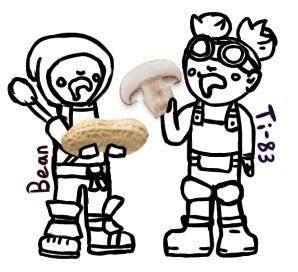




#dimension 20#dimension twenty#d20 fantasy high#art#d20#dropout#digital art#art tag#artwork#tiny heist#d20 tag#d20 spoilers
19 notes
·
View notes
Text

only Riz may take stress tokens for someone else
#OBSESSeD#riz gukgak#riz#riz fantasy high#fantasy high riz#riz fh#fh riz#d20#d20 fh#d20 fanart#d20 art#dimension 20#dimension 20 fanart#fanart#kalina#the bad kids#fhjy#dimension 20 fhjy#d20 fhjy#fhjy spoilers#fantasy high junior year#dimension20#fantasy high#d20 spoilers#d20 tag#d20 fantasy high#the ball fh#the ball d20#ankara#cassandra
2K notes
·
View notes
Text

zac has a dice bag with gorgug's name on it. if you even care
#fantasy high junior year#fantasy high#dimension 20#fantasy high junior year spoilers#d20 spoilers#kind of??#fantasy high tag#d20 tag#text post tag
1K notes
·
View notes
Text
Because I saw a post about this again: I find the common fandom belief that Laura is a particularly chaotic player baffling. She is a great player! She is an exceptional actor! She is also easily one of the most cautious players in popular actual play. The cupcake move was great as a narrative/character choice, but it relied entirely on an existing item and spell, and the stakes, while high, were unlikely to be lethal and certainly not game-breaking. I would ALSO push back on the idea of calling players "chaotic" when you actually mean "makes bold choices" or "made the GM laugh;" Emily Axford is a genuinely bold player and also has a profound respect for GMs and the stories they are telling.
#cr tag#d20 tag#i feel like I make this post annually but it remains true#like. chaotic play is bad actually; fortunately these players are good.
277 notes
·
View notes
Text
fantasy high junior year. junior year. oh my god. guys. guys they're going t. guys in january
155 notes
·
View notes
Text
Botanic Tournament : Main Bracket !
Round 3 Poll FFF

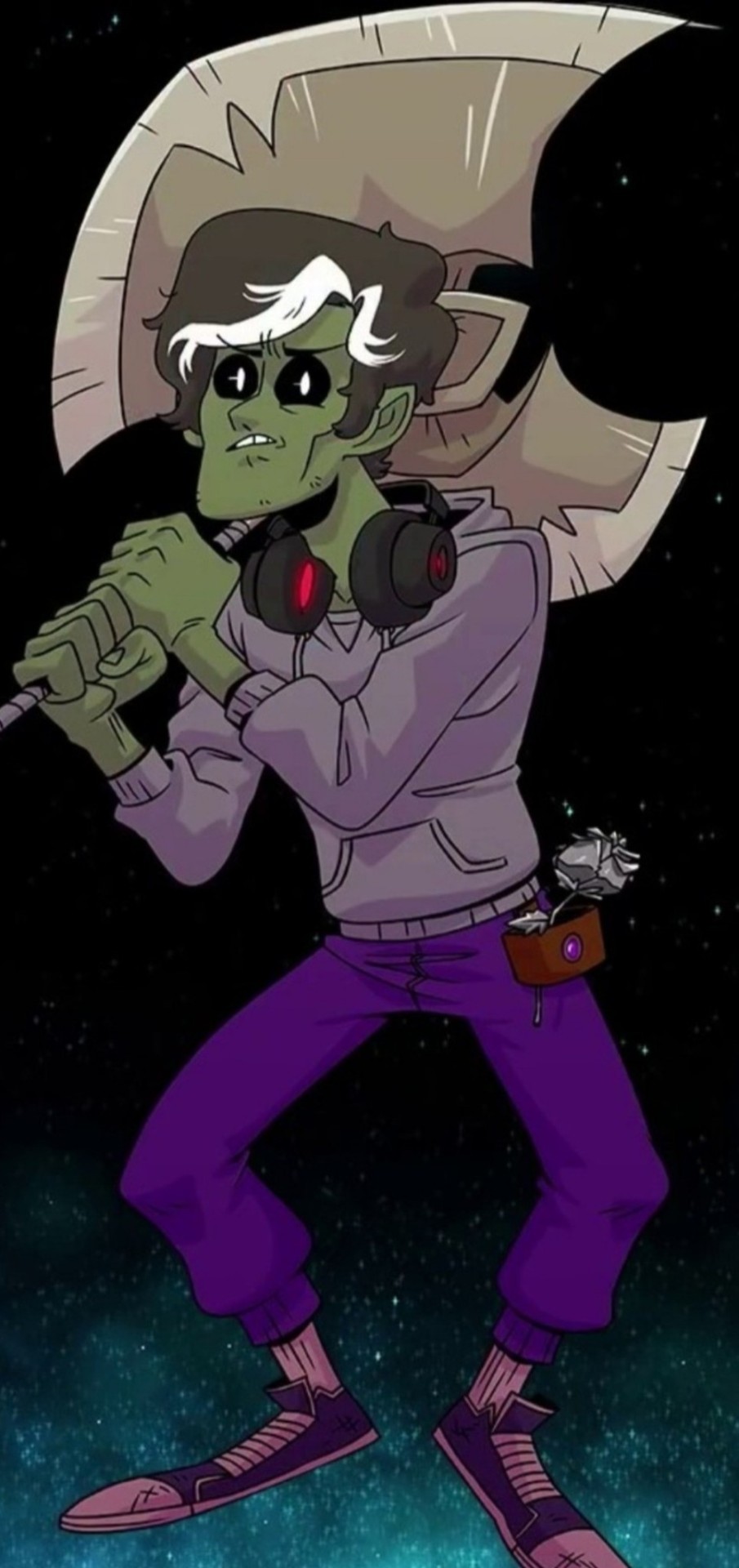
Hau is Hawai'ian for sea hibiscus


(Sea hibiscus and thistle)
#botanic tournament#tournament polls#round 3#hau pokemon#pokemon hau#pokemon manga#pokemon games#pokemon anime#pokemon#pokémon anime#pokémon manga#pokémon games#pokémon#pkmn#pokeblr#d20#d20 fantasy high#d20 tag#dimension 20#dimension twenty#gorgug fantasy high#gorgug thistlespring#fantasy high#dimension 20 fantasy high#podblr
73 notes
·
View notes
Text
this is how I’m picturing Rapunzel btw
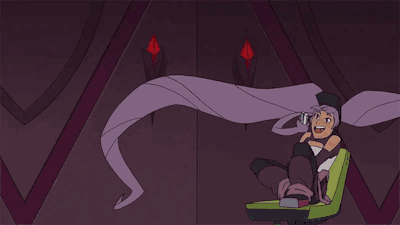
24 notes
·
View notes
Text
my thoughts on tonight's fantasy high episode: BOY do i hate being RIGHT all the time!
#:)#weeks in the reddit trenches and for what. just to be proven correct? i love being me#text post#d20 tag
2 notes
·
View notes
Text
[SPOILERS FOR NEXT EP MAYBE ?]
took a look thru the preview for ep 4 and these were the new reputation rankings if anyone’s curious (correct me if i’m wrong)
⚪⚪⚪⚪⚪⚪🔴 chirp (+1)
⚪⚪⚪⚪⚪⚪🔴 squak (+1)
⚪⚪⚪⚪🔴⚪⚪ andhera (+1)
⚪⚪⚪⚪🔴⚪⚪ hob (+1)
⚪⚪⚪⚪🔴⚪⚪ rue (-1)
⚪⚪🔴⚪⚪⚪⚪ gwyndolin (-1)
60 notes
·
View notes
Text
Dropping some art here for any other Dimension 20 fans. I absolutely loved A Court of Fey and Flowers, and K.P. was amazing😭
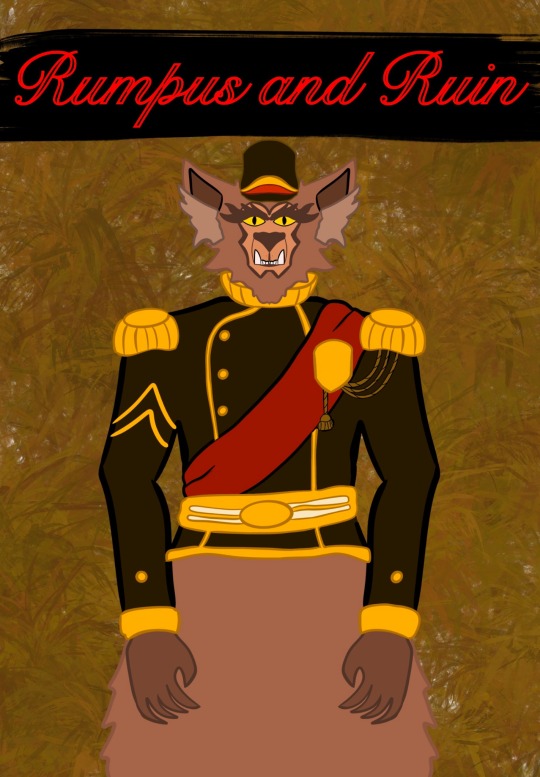
#dimension 20#a court of fey and flowers#acofaf#brennan lee mulligan#aabria iyengar#d20 a court of fey and flowers#d20 tag#d20 art#d20 fanart
30 notes
·
View notes
Text
DEVASTATED that grandfather didn’t end up having a one night stand with wanessa
#acofaf#a court of fey and flowers#d20#d20 acoc#d20 tag#dimension 20#aabria iyengar#brennan lee mulligan#emily axford#lou wilson#omar najam#oscar montoya#surena marie
47 notes
·
View notes
Text

Fallinel Yulenear Card from the Bad Kids!
#d20 fh#fh#fhjy#d20#d20 tag#d20 art#d20 fanart#d20 fantasy high#dimension20#dimension 20#fabian#gorgug#adaine#riz#kristen#fig#gorgug thistlespring#ayda aguefort#figueroth faeth#fig faeth#fabian aramais seacaster#fabian seacaster#adaine o'shaughnessey#adaine abernant#riz fantasy high#fantasy high riz#riz gutgak#riz gukgak#riz fh#fabian fh
749 notes
·
View notes
Text

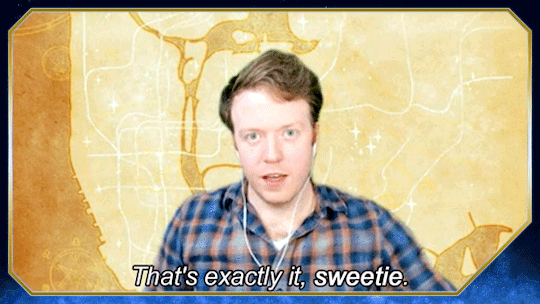
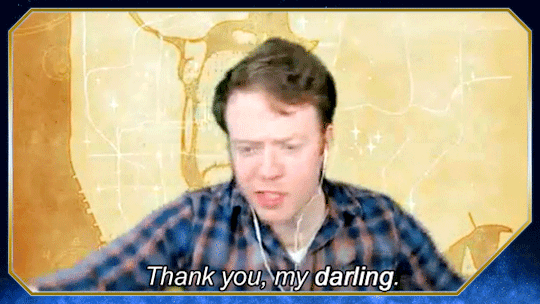
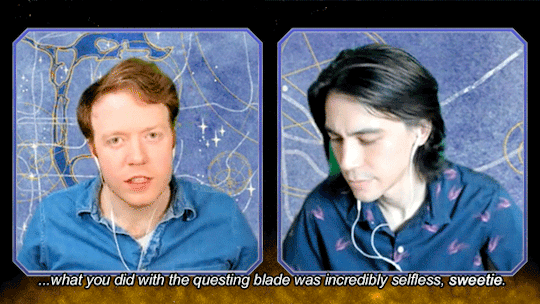
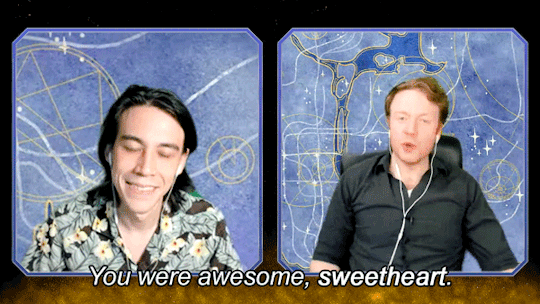



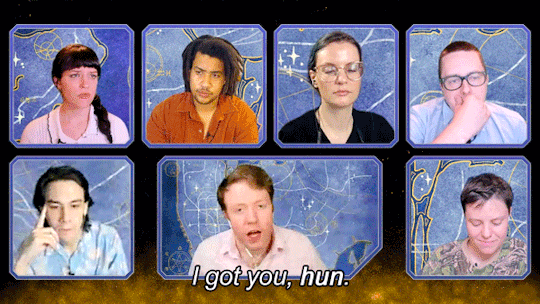

esther sinclair + pet names for ricky
for @writer-and-thrasher for @d20exchange!!
#this is not even all of the times she calls him a pet name either <3#she uses cute nicknames for him so much in tuc ii it's adorable#dimension 20#d20exchange2023#the unsleeping city#tucedit#d20edit#d20#mine tag#d20 tag#tuc tag
88 notes
·
View notes
Text
Dimension 20's Failed Genre Experiments
(This is the "Has Dimension 20 lost its touch?" post I’ve alluded to; please enjoy some genuine criticism masquerading as a riff on those sorts of articles for other shows.)
Dimension 20's debut and flagship burst onto the scene with a simple and elegant premise. What if a John Hughes movie were set at a high school for D&D adventurers? Its next full length pre-recorded season was the similarly strong urban fantasy The Unsleeping City, which in turn was followed up by the channel’s most ambitious outing yet: the Game of Thrones in Candyland mash-up, A Crown of Candy.
Widely considered to be a watershed moment for the show, A Crown of Candy explored darker themes on a famously comedic platform, was the first on the channel to have permanent player character deaths, added new mechanics and limited what the players could choose to fit the world to support this more serious tone, and on a structural level, was a welcome departure from the prior rigid alternation between episodes of combat and episodes without. It was filmed prior to the pandemic but went to air in early April 2020, when many livestreamed actual play shows were on pause and even some podcasts were scrambling to figure out remote recording. D20 introduced their talkback show as a way for the cast to hang out remotely and chat about each episode, and Adventuring Party has remained a companion to the main show. The channel had hit its stride.
Its House of the Dragon sidequest, The Ravening War, aired three years later. Despite a complicated reaction to its announcement, it was a well-received outing, but one on what had by that time become a noticeably bumpy road.
Sidequests like The Ravening War are what D20 calls its shorter, 4-10 episode seasons that do not feature the main “Intrepid Heroes” cast in full nor necessarily feature Brennan Lee Mulligan as DM. We've seen everything from the perspective of the villains in both a Lord of the Rings clone (Escape from the Bloodkeep) and a Dracula homage (Coffin Run); to a Regency romance in the Feywild (A Court of Fey and Flowers). In addition to Mercer, Jasmine Bhullar and Gabe Hicks have each run a sidequest, and Aabria Iyengar has run three. And while the Intrepid Heroes' only venture outside D&D so far is the D&D-inspired Star Wars 5e, sidequests have been run in various Kids on Bikes hacks and Hicks' own Mythic system, as their shorter format makes it even easier to experiment with the parodies, pastiches, and mash-ups the channel is known for.
There have however been two notable failed experiments, and their close proximity (both released within the past year) could be a hiccup, or could be a sign that D20’s ambition, while admirable, could use some serious reining in. They are Neverafter and Burrow's End.
Marketed as the horror season, crossed over with fairy tales, Neverafter started out strong. Only three episodes in, there was an unprecedented (for D20) total party kill. The subsequent episode is the zenith of the season, in which each character is brought back, most of them changed and twisted by the experience, playing out an analysis of their role as an archetype within these stories: Sleeping Beauty and the classic roles of The Princess (introducing such NPCs as Cinderella and Snow White), for example; or Puss in Boots as The Trickster.
Unfortunately, the quality dropped soon after. It was revealed that the darkness spreading across the fairytale multiverse was due to the influence of The Authors, and the story began to be one about the concept of stories...while still trying to incorporate not only the plotlines of the fairy tales the main PCs were from, but also an intertwined conflict between the fairies and the princess NPCs. With this, the horror, with a few exceptions, melted away: violence and monsters are standard D&D fare, and when heroes race to save the world and victory seems not only possible but likely, any distinction between horror and a typical D&D heroic fantasy is lost.
It’s not the first overstuffed campaign, but it certainly is the first one that fails to land on several levels. Starstruck Odyssey is similarly chaotic and rushed at times, but it consistently sticks to a broad message of personal autonomy and freedom within late-stage capitalism. Mulligan is famous for his capacity to spin endless dense lore off the cuff, and if it at times overcomplicates the plot of the packed and colorful comedic space adventure, at least it contributes to the baked-in excess of the setting. But Neverafter's postmodern flourishes against a horror backdrop desperately needed an injection of sparseness and silence it never received.
This is enhanced by the nature of actual play: with a few exceptions, even when filmed and even with the elaborate production values of Dimension 20, it is first and foremost primarily an auditory medium. We only know what is narrated to us. Neverafter did not permit its audience the time and space to fear the unknown. The existential horror of the metanarrative, of being a character doomed to a specific ending, while touched on by some of the cast (particularly Siobhan Thompson’s Sleeping Beauty), took a backseat to models of giant spiders and tales of undead dwarves. The story lacked the room to build real tension, but also failed to adequately create the claustrophobia of being truly trapped within its narrative. It feels more stuffy than unsettling.
Burrow's End is far less airless, but profoundly disjointed. Neverafter thought it knew what it was, but Burrow's End went through multiple identity crises by the halfway mark, and the marketing for the series reflects this.
The initial trailer makes it seem like a cute if dramatic story about a family of stoats - think Redwall, think Wind in the Willows. The first episode was excellent, however, and sold many who had been unimpressed by the trailers on the series, with its well-played setup of the clear Watership Down/Mrs. Frisby and the Rats of NIMH parallels with a unique twist in the form of The Blue.
The promotion took a strange turn, however, with the second episode and its infamous bear carcass battle map. It was hyped as uniquely horrifying, with a teaser video posted of the cast shrieking as the map, unseen by the audience, was wheeled past them. This seemed rather cavalier of the channel once the episode was posted, accompanied by a gore content warning covering a period of well over an hour...which was then further undercut by an exquisitely crafted, but ultimately rather tame display of a bear's innards. It was left out on the table during Adventuring Party as well, further reducing the idea of any meaningful shock factor (or any attempt to accommodate those in the audience who were triggered). The combat this map was for was a creative one, and the episode itself high quality, but it furthered the sense that Dimension 20 itself was unsure of what they were trying to get people to watch.
The series continued on with two more excellent episodes as it reached Last Bast, a clearly man-made structure full of thousands of stoats, with a strong dash of the police state. The actors immediately clocking the flaws of this society, but their stoat characters having no similar sense, led to a fascinating tension. However, the Blue (called the Light in Last Blast), previously described as some animating force and driver of magical power, and mysteriously concentrated in the brain of the dead-but-animated bear, was then revealed to be ionizing radiation.
At this point, the details of my own life become relevant. My career is in the field of health physics. I hold a master’s degree in this specialty and have served as a radiation safety officer, though not at a reactor. I don’t think that this background is a requirement to understand the structural issues of this season; but it certainly made me particularly attuned to the flaws.
Before you claim that this is just a show and who cares: In addition to my love of actual play, I am also a fan of comics and all sorts of speculative fiction. I am well aware that Spider-Man’s “radioactive blood” would not realistically grant him spider powers; I know that going into a high radiation field would not create Doctor Manhattan; I know that Superman does not actually have ‘x-ray vision’, and I know that radiation creates neither kaiju nor rad roaches. This is fine. In comics, radiation is a shorthand for “mad science” or “mysterious powers” with a sense of the lethal and the eldritch and the hubristic. The story is not so much about the source of these powers, but rather the great responsibilities they require. Godzilla, meanwhile, is clearly a metaphor for the very real nuclear devastation of Hiroshima and Nagasaki, and Fallout is an anti-proliferation and anti-war message with nuclear annihilation as the set up for its post-apocalyptic setting. These works understand that radiation is a limited-use plot device, and, wisely, they keep it simple.
Burrow’s End, by placing radiation front and center, has lost the message. The themes of the story are irretrievably muddled: what seems like a tale of family displaced by human intervention now positions a man-made hazardous material as both sinister corruption and divine boon, and engages neither with a fitting narrative of both the pros and cons of technology, nor of human and animal symbiosis. The finale establishes the latter in a rushed cut scene reliant on a single persuasion roll, and the two episodes prior to that meanwhile establish that while the humans first introduced radiation to the ecosystem, the first five stoats were the ones who sought it out and disseminated it and built the police state, and their true nemesis was Phoebe, one of their own. This culminates with Phoebe, the previously unseen fifth of the first five stoats (who have by now already been killed by the heroes), piloting the body of a 20-years-dead human, threatening to somehow cause global radiation contamination as her grand Evil Scheme. Unnecessarily, from a narrative perspective, I might add; this occurs after the final combat has already begun and she is magically controlling two of the party members. They’re already going to kill her. It’s a hat on a hat on a hat, and the humans are incidental.
When I was a child, I was enamored with the sort of stories in which children are sent to another time or place and then return with seemingly no time passing, and at one point excitedly told my mother I had an idea for a story, of what happens back while you’re time traveling. My mother, a fan of speculative fiction herself, and never one to coddle, told me “nothing, honey, that’s the point.” I wonder if something similar happened here; an attempted deconstruction of those radiation-granted superpower tropes, focused so hard on being clever it overshot into something anything but. Other elements of the story - particularly the weak pun of “copper” to hammer home the already obvious theme of population support being the arm of the police - make me think this was indeed an attempt at cleverness that missed the mark.
I am happy to elaborate on the flaws of the science elsewhere but I think the most succinct way to put it is that while the biology and habits of stoats sans radiation has been considered with what seems to be at least a modicum of love and care (their use of pre-existing burrows, Viola’s pregnancy), the radiation science/understanding of recent nuclear history can only be described as abysmally neglectful, in and out of game. They let a Loss of Coolant Accident go on for three days with a remarkably casual attitude? This disaster was sufficient to result in what appears to be an exclusion zone (of which there have been three, ever, in human history; two of which are the immediately recognizable Chernobyl and Fukushima) and yet it isn’t being monitored closely enough for someone to notice that there’s been penned animals next to the building for years (let alone that the building itself is teeming with stoats)? For that matter, they’re opening the site only twenty years later? After the “radiation dust”, apparently present on the fully maintained roads by the reactor, but neither within nor in front of the reactor, just now made 14 people bleed out (not how Acute Radiation Syndrome works; also 14 deaths from ARS in 1982, when the series is set would in fact be an unprecedented disaster. In our world, Chernobyl - which had not yet happened in 1982 - is the only nuclear accident that exceeds that ARS death toll.)
Radiation becomes an all-purpose plot engine with no internal consistent logic: it kills humans swiftly and brutally (though based on statements by Dr. Tara Steel and the fact that she seems fine in only a hazmat suit - which shields from contamination but will stop neither gamma nor neutron radiation - only via inhalation). But it infects chipmunks and bears with corruptive and bizarre neurological effects, turns wolves into horrifying but loyal hybridized monstrosities, and conveys to stoats not just human intelligence, but mastery of human language, magic spells, and the ability to come back as a revenant through force of will…though it also can immediately kill them, but also extend their lifespans, but also cause them to slowly mutate into wolves (but not through DNA splicing transfer, that would be silly). It kills 14 humans nearly instantly with off-site dust, but another survives a fiery attempted core meltdown with no apparent ill effects.
There is an excellent and thoughtful story about family, generational trauma, and political structures somewhere under here, and the incredible cast does its damndest to sell it, but it is all but lost beneath a sci-fi whodunnit that would make Ed Wood cock a skeptical eyebrow.
Neverafter and Burrow’s End’s respective collapses under the weight of ambition coincide, perhaps unintentionally, with some of the more dubious film editing choices on Dimension 20. Filmed actual play can be visually unexciting, and Dimension 20 has used simple shot/reverse shots, as well as some sound effects (notably for critical hits and fails) throughout its run to break it up. Neverafter, however, is marked by deliberate hisses and glitches, fractured split screens, echoey vocal effects, and nails-on-chalkboard screeches. This did not add to the atmosphere as intended; at best they were irritating and for many made it actively harder to hear key dialogue. Burrow’s End’s editing has been simpler, mostly relying on some, to be fair, well-placed cuts to black and voice distortion to indicate taped or radioed segments; but a key moment - Jaysohn’s potentially fatal rush into radioactive waters - is undercut with a frankly cheesy montage. Others I spoke to compared it to Indian soap operas, 1960s Doctor Who, The Oscars In Memoriam video, and reality show farewell reels. It takes what could be a tense potential character death - something D20 already handles wonderfully with their iconic Box of Doom - and makes it cheap and tacky, particularly jarring given the beautiful and haunting shadow puppet animation the season had previously delivered to convey the stoat creation myths. (And then, when Ava falls into the waters herself saving him, she merely comes back as a revenant with no ill effects. The stakes were never there to begin with in this smoke and mirrors season.)
Praise for Dimension 20 often hinges on its original innovative structure; most actual play shows skew towards more longform storytelling. However, the short format comes with a price. The fixed length of D20 seasons and the elaborate, custom made maps require a deft GM that can guide players to the exact right place without it seeming forced. Threading the needle is harder than it looks; even the otherwise iconic Fantasy High debut season stumbled towards the end when the players were too good at uncovering the mystery, and Mulligan had to place their characters in an inescapable prison in order to pad out a pre-scheduled episode before the finale. Perhaps the strain of this constant need to live up to a reputation as high-concept innovators, rather than simply create something good and cohesive, is beginning to show. The higher production values in Neverafter and Burrow’s End cannot hide their messy plots and confused messages, and indeed only highlight them. One interview said that for Burrow’s End, Iyengar wants the audience to trust her; after Burrow's End, I can’t say I do.
The next Dimension 20 season after Burrow’s End is a long-awaited return home to the flagship: Fantasy High Junior Year. Let’s hope this reminds the channel where they came from, and what magic they are capable of making when they keep it simple.
162 notes
·
View notes
Text
you know how modern tv has spinoffs of everything? i think that d20 should announce one of those. two simultaneous campaigns that occasionally cross over, like ncis. here are some ideas i had
dimension 20... 2!
dimension 22
dimension 2d6 (they only play pbta)
dimension 20: nyc (filmed in nyc, not a tuc thing)
dimension 20: the iyengar years (give aabria a permanent show)
#waveridden.txt#d20 tag#i like this joke but it's not doing well enough on twitter so i'm putting it here
62 notes
·
View notes
Text
Botanic Tournament : Main Bracket !
Round 3 Poll NNN


Jaskier, the character's name in the original, Polish version means Buttercup. Editors changed it into Dandelion in some English versions



(Buttercup, dandelion and apples)
#botanic tournament#tournament polls#round 3#jaskier the bard#jaskier the witcher#jaskier witcher#witcher jaskier#the witcher jaskier#the witcher#witcher games#the witcher games#witcher fandom#the witcher fandom#kristen applebees#d20 fantasy high#d20 tag#d20#dimension 20 fantasy high#dimension 20#kristen fantasy high#fantasy high
35 notes
·
View notes